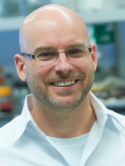Seeding the meiotic DNA break machinery and initiating recombination on chromosome axes Journal Article
| Authors: | Dereli, I.; Telychko, V.; Papanikos, F.; Raveendran, K.; Xu, J.; Boekhout, M.; Stanzione, M.; Neuditschko, B.; Imjeti, N. S.; Selezneva, E.; Tuncay, H.; Demir, S.; Giannattasio, T.; Gentzel, M.; Bondarieva, A.; Stevense, M.; Barchi, M.; Schnittger, A.; Weir, J. R.; Herzog, F.; Keeney, S.; Tóth, A. |
| Article Title: | Seeding the meiotic DNA break machinery and initiating recombination on chromosome axes |
| Abstract: | Programmed DNA double-strand break (DSB) formation is a crucial feature of meiosis in most organisms. DSBs initiate recombination-mediated linking of homologous chromosomes, which enables correct chromosome segregation in meiosis. DSBs are generated on chromosome axes by heterooligomeric focal clusters of DSB-factors. Whereas DNA-driven protein condensation is thought to assemble the DSB-machinery, its targeting to chromosome axes is poorly understood. We uncover in mice that efficient biogenesis of DSB-machinery clusters requires seeding by axial IHO1 platforms. Both IHO1 phosphorylation and formation of axial IHO1 platforms are diminished by chemical inhibition of DBF4-dependent kinase (DDK), suggesting that DDK contributes to the control of the axial DSB-machinery. Furthermore, we show that axial IHO1 platforms are based on an interaction between IHO1 and the chromosomal axis component HORMAD1. IHO1-HORMAD1-mediated seeding of the DSB-machinery on axes ensures sufficiency of DSBs for efficient pairing of homologous chromosomes. Without IHO1-HORMAD1 interaction, residual DSBs depend on ANKRD31, which enhances both the seeding and the growth of DSB-machinery clusters. Thus, recombination initiation is ensured by complementary pathways that differentially support seeding and growth of DSB-machinery clusters, thereby synergistically enabling DSB-machinery condensation on chromosomal axes. © The Author(s) 2024. |
| Keywords: | adult; controlled study; protein phosphorylation; unclassified drug; genetics; nonhuman; protein localization; cell cycle protein; chromosome; mouse; synaptonemal complex; animal; meiosis; metabolism; animals; cell cycle proteins; mice; animal tissue; homologous recombination; enzyme inhibition; nuclear protein; carboxy terminal sequence; protein protein interaction; animal experiment; protein; dna; genetic recombination; recombination, genetic; dna breaks, double-stranded; double stranded dna break; phosphotransferase; biogenesis; hormad1 protein; condensation; inhibition; male; article; dbf4 dependent kinase; seeding; iho1 protein; homologous chromosome |
| Journal Title: | Nature Communications |
| Volume: | 15 |
| ISSN: | 2041-1723 |
| Publisher: | Nature Publishing Group |
| Date Published: | 2024-04-05 |
| Start Page: | 2941 |
| Language: | English |
| DOI: | 10.1038/s41467-024-47020-1 |
| PUBMED: | 38580643 |
| PROVIDER: | scopus |
| PMCID: | PMC10997794 |
| DOI/URL: | |
| Notes: | Article -- MSK Cancer Center Support Grant (P30 CA008748) acknowledged in PubMed and PDF -- Source: Scopus |
Altmetric
Citation Impact
BMJ Impact Analytics
Related MSK Work





